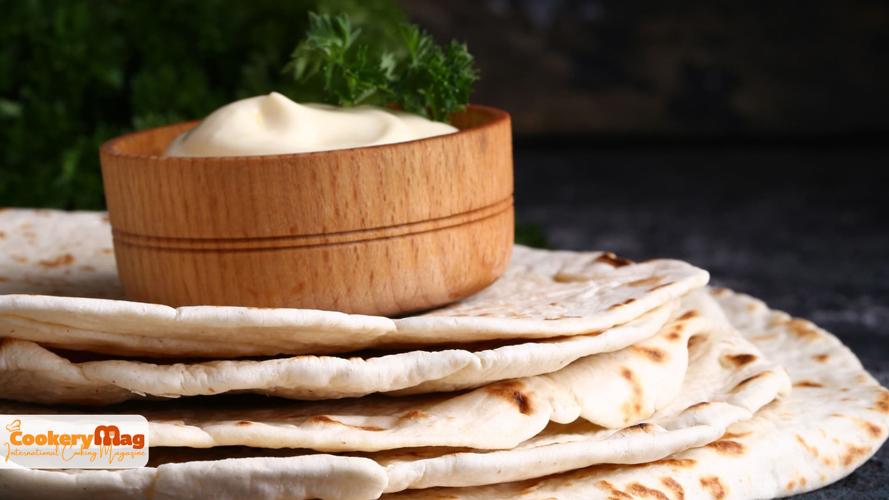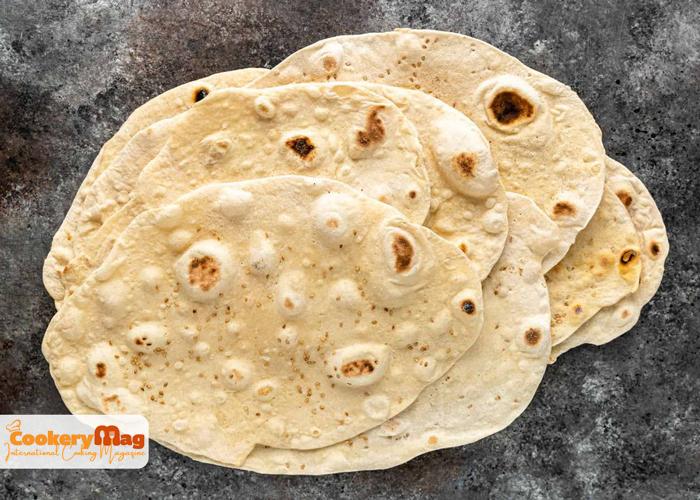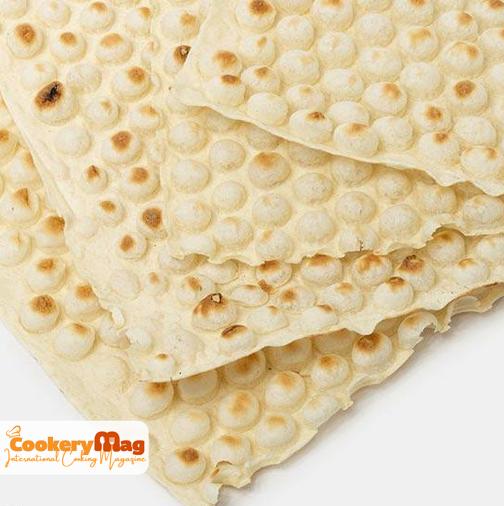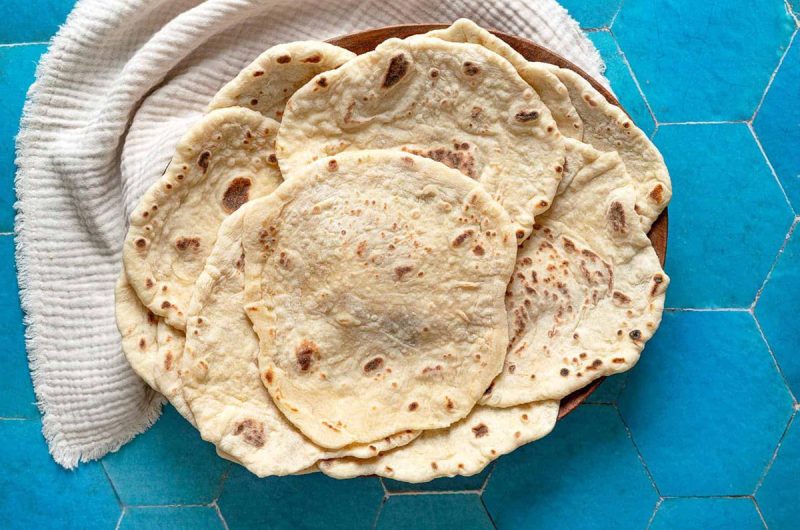© All Rights Reserved.
Lavash Bread Recipe | Delicious Armenian Flatbread
Lavash Bread, another popular and widely consumed traditional bread, which has been baked in Iran since ancient times.
Lavash bread is cooked in different ways in different cities in Iran and different countries of the world, stay with Cookery Magazine to gain an amazing and easy recipe.
For example, homemade lavash and saji bread of Qazvin have been cooked in all homes since the distant past and have gained great fame. But in general, lavash bread is basically a very thin bread. This bread can be stored for a long time.
Usually, lavash bread, which is produced by traditional baking, does not contain bran. In addition, sometimes high amounts of salt are used in baking this bread, which can be harmful to health.
Ingredients for making Lavash Bread
| Flour | 2 cups |
| Sugar | 1 teaspoon |
| Yeast | 1 teaspoon |
| lukewarm water | 1 cup |
| liquid oil | 5 tablespoons |
| Salt | 1 teaspoon |
Recipe for making Lavash Bread | Armenian Flatbread
The first step
First, we pour yeast, sugar and half a glass of water into a bowl and slowly mix with each other and leave it aside for 10 minutes to process.
Then we sift the flour, pour it into a large bowl, and make a hole in the middle of the flour to open it.
The second step
Then, we add salt, liquid oil, yeast, and the remaining half of the water and mix the flour with the ingredients little by little.
In the same way, we knead the mixture with our hands until the dough no longer sticks to our hands and it becomes smooth and soft.

The third step
The obtained dough is collected easily, and we put it in the middle of the bowl and cover the bowl with cellophane and put the bowl in the corner of the kitchen and put a thick clean cloth or towel on the bowl to cover it and to Let the dough rest for 1 hour.
The fourth step
After 1 hour, we remove the cellophane and knead the dough a little until it becomes puffy, Sprinkle a little flour on the flat surface, divide the dough into small balls, and place each ball on the floured flat surface.
The fifth step
The dough that we divided should be in the thickness that we want, in the shape of the pan that we want to open with a rolling pin.
For example, if your pan is rectangular, you should open the dough with a rolling pin in a rectangular shape.
The sixth step
In addition to the desired thickness for the bread, you should pay attention to the fact that if your pan is rectangular, the dough should be the same size and shape.
Be careful; if you are making bread for the first time, make the size of the bread smaller than the pan.
The seventh step
This will make it easier to carry the dough when transferring it to the pan. Next, we put the pan on low heat and let it heat up over time and put the prepared dough in the pan.
The eighth step
Then we let it catch itself and puff up a little, and then we slowly turn it over so that the other side of the bread also cooks and gets colored.
It is better to eat the prepared bread at the same time and cook fresh lavash bread for each occasion.
Having a journey in the history of Armenian Flatbread
Since bread has a very long history, in the case of some old breads such as lavash, it is not possible to say exactly where they were baked for the first time or where their origin originates from.
However, some historians consider its original birthplace to be Armenia, and some others consider the word Lavash to be the root of the Middle Persian language (Pahlavi), which we will discuss further.
As a result, various stories have been told about the history of lavash bread.
Lavash bread, which is also called tandoori bread, has been widely used in the Eastern Mediterranean, Asia Minor, Iran and other yellow-skinned regions for a long time.
In addition, it is said that the tradition of baking lavash bread as a skill and culture was transferred from Iran to neighboring countries.

In terms of nutrition, bread has had a significant place in human history. It can be said that the history of making bread goes back to the Stone Age.
During that period, people learned to mix water with ground seeds to make a paste. Then, they exposed the paste to fire to make bread.
This type of bread is called lavash in Iran and lavash in the Republic of Armenia. In Georgia, it is called “Somkhori Lavashi,” which means Armenian Lavash.
In Hebrew’s food encyclopedia, it has been written about its origin that its origin is from the Middle East, from Iran, and some have considered its origin to be Sumerian.
Although lavash bread is 800 years old in Iran, it was registered as a spiritual heritage of Armenia by UNESCO in 1932. But a little later, at the request of Iran, it was jointly registered with UNESCO.
In its 11th meeting, the UNESCO organization engraved the culture of making lavash bread as an intangible cultural heritage of Iranians. Azerbaijan, Kazakhstan, Kyrgyzstan, and Turkey also have the same tradition similar to ours.
Most of the time, people of different regions of Iran cook lavash bread flat in an oven called “tandoor”, but nomads cook lavash on a “saj pan” (a flat metal or stone surface).
It should be noted that the old ovens were generally made of stone or clay and were installed on the ground. However, nowadays, lavash bread is baked in ovens built into the walls.
The age of this bread can be seen from its presence in the poetry of some poets such as Rumi and Nizar Qabbani.
Evliya Çelebi (Ottoman traveler) in 1655 mentioned the lavash bread in Qazvin, and Chardin also mentioned it as lavach.
Thin flat bread became popular in this part of the world after 1912. At first, this type of bread was not liked by many people. They thought it could not last long and would lose its flavor.

Apparently, this bread was not in Tehran until the end of the 19th century, and it was brought from the surrounding villages as a souvenir.
In the mid-1980s, lavash bakeries installed ovens that were level with the floor, and workers worked sitting down. This bread was known as ground lavash.
However, later it attracted the favorable opinion of more people. Of course, the method of preparing and baking bread and raw materials has been somewhat diverse among different nations.
Physical features of Armenian Flatbread
Armenian Flatbread is made from flour, water, yeast, and salt. Lavash is a round or oval-shaped, very thin, 2-5 mm, usually standard-sized bread.
Lavash is usually 90-110 cm long, 40-50 cm wide, and weighs no more than 250 grams.
In open conditions and without bread covering, lavash dries quickly and can be kept dry for a long time (more than 1 year).
Sometimes, sesame or poppy seeds are sprinkled on this bread. But the original lavash bread is very thin.
As long as this bread is soft, it is similar to a tortilla, and usually, most people like fresh and soft lavash bread, but this bread dries and hardens quickly when exposed to airflow.
Dry lavash bread is also used in some religious ceremonies, such as the Thanksgiving ceremony of Orthodox Christians.
Nutritional value of Armenian Flatbread
Armenian Flatbread does not contain bran, and eating it is like consuming sugar and makes a person obese; Its vitamins are also zero, so it is recommended that students do not eat lavash bread.
Emphasizing the need for parents to pay attention to feeding their children at school, a nutritionist said consuming Armenian Flatbread is not recommended for students because it does not contain any vitamins and causes obesity.
Conclusion
Thank you for being with us with this delicious and popular Persian bread under the title of Lavash or Armenian Flatbread. If you have any questions, it’s my honor to answer. Enjoy your exploration of Persian cuisine!
Armenian Flatbread is one of the traditional Iranian breads, which is so delicious and many foods like Sambose are made out of it.
Please share this article with your friends on Facebook, Twitter, Pinterest, and other social media. 🧡
Lavash Bread Recipe
Course: BreadCuisine: Persian Bread, Persian FoodDifficulty: Easy4
servings20
minutes10
minutes300
kcalIngredients
Flour, 2 cups
Sugar, 1 teaspoon
Yeast, 1 teaspoon
lukewarm water, 1 cup
liquid oil, 5 tablespoons
Salt, 1 teaspoon
Directions
- The first step
First, we pour yeast, sugar and half a glass of water into a bowl and slowly mix with each other and leave it aside for 10 minutes to process.
Then we sift the flour, pour it into a large bowl, and make a hole in the middle of the flour to open it. - The second step
Then, we add salt, liquid oil, yeast, and the remaining half of the water and mix the flour with the ingredients little by little.
In the same way, we knead the mixture with our hands until the dough no longer sticks to our hands and it becomes smooth and soft. - The third step
The obtained dough is collected easily, and we put it in the middle of the bowl and cover the bowl with cellophane and put the bowl in the corner of the kitchen and put a thick clean cloth or towel on the bowl to cover it and to Let the dough rest for 1 hour. - The fourth step
After 1 hour, we remove the cellophane and knead the dough a little until it becomes puffy, Sprinkle a little flour on the flat surface, divide the dough into small balls, and place each ball on the floured flat surface. - The fifth step
The dough that we divided should be in the thickness that we want, in the shape of the pan that we want to open with a rolling pin.
For example, if your pan is rectangular, you should open the dough with a rolling pin in a rectangular shape. - The sixth step
In addition to the desired thickness for the bread, you should pay attention to the fact that if your pan is rectangular, the dough should be the same size and shape.
Be careful; if you are making bread for the first time, make the size of the bread smaller than the pan. - The seventh step
This will make it easier to carry the dough when transferring it to the pan. Next, we put the pan on low heat and let it heat up over time and put the prepared dough in the pan. - The eighth step
Then we let it catch itself and puff up a little, and then we slowly turn it over so that the other side of the bread also cooks and gets colored. It is better to eat the prepared bread at the same time and cook fresh lavash bread for each occasion.
Frequently Asked Questions about Noon Lavash
What is the difference between Taftoon bread and lavash?
Taftoon bread and lavash bread are very similar and are distinguished only by the type of flour used and relative thickness.
Why is it not good to use too much baking soda in the bakery?
It endangers people’s health, which causes people to suffer from malnutrition and digestive disorders in long-term feeding.
How long does it take to cook lavash bread?
This time takes between 10-40 seconds, depending on the type of bakery oven.
Can you use milk instead of water?
Using lukewarm milk, in addition to making your bread tastier, also has a positive effect on its texture, and the bread stays softer.


